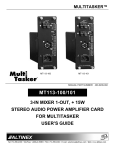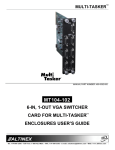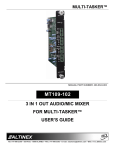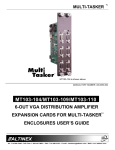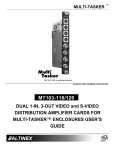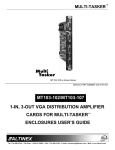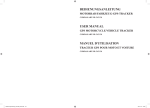Download Altinex MT113-101 User`s guide
Transcript
MULTI-TASKER MANUAL PART NUMBER: 400-0209-001 MT113-100/101 3-IN MIXER 1-OUT, + 15W STEREO AUDIO POWER AMPLIFIER CARD FOR MULTI-TASKER. USER’S GUIDE MULTI-TASKER TABLE OF CONTENTS Page PRECAUTIONS / SAFETY WARNINGS ...............2 GENERAL ..........................................................2 INSTALLATION..................................................2 CLEANING.........................................................2 FCC / CE NOTICE..............................................2 ABOUT YOUR MT113-100/101.............................3 TECHNICAL SPECIFICATIONS............................3 DESCRIPTION OF MT113-100/101 ......................4 APPLICATION DIAGRAM .....................................4 APPLICATION 1.................................................4 APPLICATION 2.................................................5 INSTALLING YOUR MT113-100/101 ....................8 OPERATION .........................................................8 RS-232 CONTROL.............................................8 RS-232 INTERFACE ..........................................8 DESCRIPTION OF COMMANDS .......................8 SUMMARY OF COMMANDS ...........................12 TROUBLESHOOTING GUIDE ............................12 ALTINEX POLICY ...............................................18 LIMITED WARRANTY......................................18 RETURN POLICY ............................................18 CONTACT INFORMATION ..............................18 1 1 MULTI-TASKER PRECAUTIONS / SAFETY WARNINGS • 1 Please read this manual carefully before using your MT113-100/101. Keep this manual handy for future reference. These safety instructions are to ensure the long life of your MT113-100/101 and to prevent fire and shock hazard. Please read them carefully and heed all warnings. 1.1 GENERAL • • • • • • Qualified ALTINEX service personnel, or their authorized representatives must perform all service. To prevent fire or shock, do not expose this unit to rain or moisture. Do not place the MT113-100/101 in direct sunlight, near heaters or heat radiating appliances, or near any liquid. Exposure to direct sunlight, smoke, or steam can harm internal components. Handle the MT113-100/101 carefully. Dropping or jarring can damage the card. Do not pull the cables that are attached to the MT113-100/101. Insert the card carefully into the slots of the Multi-Tasker™ without bending any edges. When removing a card, pull it halfway through to avoid damage to internal cables. If an expansion card is being removed, please make sure that the Main card to which it is attached is also pulled out simultaneously. • 1.3 CLEANING • Clean only the connector area with a dry cloth. Never use strong detergents or solvents, such as alcohol or thinner. Do not use a wet cloth or water to clean the card. Do not clean or touch any component or PCB. 1.4 FCC / CE NOTICE • This device complies with part 15 of the FCC Rules. Operation is subject to the following two conditions: (1) This device may not cause harmful interference, and (2) this device must accept any interference received, including interference that may cause undesired operation. 2 2 This equipment has been tested and found to comply with the limits for a Class A digital device, pursuant to Part 15 of the FCC Rules. These limits are designed to provide reasonable protection against harmful interference when the equipment is operated in a commercial environment. This equipment generates, uses, and can radiate radio frequency energy and, if not installed and used in accordance with the instruction manual, may cause harmful interference to radio communications. Operation of this equipment in a residential area is likely to cause harmful interference in which case the user will be required to correct the interference at his own expense. Any changes or modifications to the unit not expressly approved by ALTINEX, Inc. could void the user’s authority to operate the equipment. MULTI-TASKER ABOUT YOUR MT113-100/101 2 TECHNICAL SPECIFICATIONS MT113-100/101 3 in Mixer, 1 fixed line level output and 30W amplifier Card FEATURES/DESCRIPTION GENERAL Inputs Input Connectors The MT113-100/101 is a Stereo Audio Power Amplifier Card designed for use with the MultiTasker™. When installed in the Basic Enclosure (MT100-100), This card allows connection of up to two line level balanced/ unbalanced inputs and 1 microphone. The Card has a built in dual 15W power amplifier. The MT113-100 has 70 Volt output for Sound reinforcement speakers and MT113-101 has Stereo Output to drive 8 Ohms speakers direct. Input 1 Input 2 Input 3 3 MT113-100/101 (3) Terminal Blocks Balanced/Unbalanced Microphone Input Line level Balanced/Unbalanced Line Level Balanced/Unbalanced Outputs Fixed Output Line Level Balanced/Unbalanced Speaker Output MT113-100 70V 30Watts Speaker Output MT113-101 8 ohms stereo 15 Wattas each speaker output Stereo or Mono Audio Compatibility Table 1. MT113-100/101 General Mixing is of input is selected via easy-to-use ASCII commands from a control system or computer connected to the RS-232 port of the MultiTasker™ Basic Enclosure. The MT113-100/101 can accept balanced or unbalanced audio inputs and the output can be wired for either balanced or unbalanced audio output. MECHANICAL MT113-100/101 Basic Enclosure Slots Three Required Weight 2.0 lb (0.45 kg) Connector Panel Black T° Operating 10°C-50°C T° Maximum 75°C Humidity 90% non-condensing MTBF (calc.) 55,000 hrs Table 2. MT113-100/101 Mechanical The MT113-100 is primarily designed to utilize the 70 Volt speaker system. It has on board Transformer to convert low impedance signal to high voltage, high impedance output signal. This card can supply tot al of 30 Watts of power to the speakers. The MT113-101 is primarily designed to utilize the standard 8 Ohms stereo speaker systems. This card can deliver full 15 Watts of power to each speaker. ELECTRICAL Input Signals Max Line Level Input Max microphone Input Power Amplifier The MT113-100/101 has separate power supply that is used to drive output of the power audio amplifier. This power supply has universal power input and can operat from 90 to 240 volts AC. MT113-100/101 0 dBu (.7V p-p) 10k Ohms -20dBu (70mv) 47 Kohm Stereo 15 Watts per channel Mono 30 Watts 70V output 10 Hz to 20 kHz Frequency Response (+/- 0.5 dB) Noise Floor -97 dB @ 20 kHz Table 3. MT113-100/101 Electrical Through RS-232 control, the MT113-100/101 can be controlled to adjust signal level of each input in 32 steps. In addition the volume, treble and bass of the output amplifier can be adjusted in 32 steps. Output Power All three inputs to the amplifier are mixing inputs and can be adjusted from 0db to –60db. 3 3 MULTI-TASKER DESCRIPTION OF MT113-100/101 4 APPLICATION DIAGRAM Application 1 4 4 5 MULTI-TASKER Block Diagrams: Internal View of MT113-100/101 5 5 MULTI-TASKER INSTALLING YOUR MT113-100/101 After processing a command, an OK or ER will be returned as feedback if "F" is included at the end of a command string or if the unit ID is zero. 6 Step 1. Slide the MT113-100/101 into an available slot in the Multi-Tasker™ Basic Enclosure in order to connect to the bus. Make sure that the MT113-100/101 card fits into place. Secure the card to the MultiTasker™ by tightening the retainer screws located on the top and bottom of the MT113-100/101 card. 7.2 DESCRIPTION OF COMMANDS Each command consists of three parts: function, card ID, and unit ID. [Function, Card ID, Unit ID] Example: [VERC3U2] VER = Function C3 = Card ID U2 = Unit ID For detailed information regarding function, see each command description. Step 2. The LED on the card panel will turn red indicating that the card is in full operation. A green LED indicates that a signal is present. An LED that is blinking red indicates that the card is experiencing a problem. If the LED is blinking, see Troubleshooting Guide in section 8. Card ID is an assigned value from 1 to 19, which represents the number of slots. Card ID 0 (C0) is used for the controller (see user’s guide for the MT100-100). Changing the position of a card will significantly affect the commands recorded on software definitions or a third party control system. Step 3. Connect audio cables from the audio source to the input connector of the MT113-100/101. Connect the output connectors of the MT113-100/101 to the audio equipment through an audio cable. Unit ID has a value from 0 to 9. Unit ID 0 should be used for single unit operation. If the Unit ID is set to 0, then each command can be used without Ui (use command [SETU0]; see user’s guide for the MT100-100). Step 4. Starting from the left, identify the slot number where the MT113-100/101 card is plugged into the Enclosure and note that it is for RS-232 control. Example: OPERATION 7 [VERC3]: for unit ID zero [VERC3Ui]: for unit ID other than zero [VERC3]: equivalent to [VERC3U0] 7.1 RS-232 CONTROL When used in the Multi-Tasker™ Enclosure, the MT113-100/101 has many advanced remote control capabilities, which are accessible through standard RS-232 communication. The actual controlling can be accomplished through a computer control system or any other device capable of sending RS-232 commands. 1. [VERCnUi] This command receives the software version and card type for the MT113-100/101 card. Cn = card ID number (n = # from 1 to 19) Ui = Unit ID (i = # from 0 to 9) (refer to the MT100-100 user’s guide for explanation) 7.1.1 RS-232 INTERFACE Example: The RS-232 commands for the MT113-100/101 are in a simple ASCII character format. 1. 2. 3. If one MT113-100/101 card is in slot #2 of unit 3: To send command [VERC2U3], the MultiTasker™ Enclosure will return: Square brackets “[ ]” are part of the command. Use uppercase letters for all commands. Commands may be executed with or without a space. [Ver A1 MT113-100_101 C02] 2. [CnUi] 8 8 MULTI-TASKER This command receives the status of the card. Command Format: [CnUi] Cn = card id (n = 1 to 19) Ui = unit id (i = from 0 to 9) (refer to the MT100100 user’s guide for explanation) Example: If all of the inputs on the MT113-100/101 card are OFF and the card is in slot #5 of unit 3: 1) [ON1C5U3]: Turns ON only input 1 of the MT113-100/101 card. 2) [ON3C5U3]: Turns ON only input 3 Example: If one MT113-100/101 card is in slot #2 of unit 3 with input 1 ON: To send command [C2U3], the MultiTasker™ Enclosure will return feedback as [On1 C02] or [On1 ER03 C02] if there is an error number 3 (see error code list). If there is no card in slot #2 of unit 3, sending the [C2U3] command will not return any feedback. 4. [OFFmCnUi] This command disables one or all inputs of a single card or a group of cards. [OFFmCnUi]: for a single card This command disables input “m” or all inputs. [OFFC5CnUi]: Turns OFF all inputs of the MT113-100/101 card. m = Input number (m = 1 to 8) n = Card ID number (n = slot # from 1 to 19) i = Unit ID number (i = 0 to 9) Example: If card 5 of unit 3 has input 1 ON, the following commands can be used to turn OFF the input. 1) [OFF1C5U3]: Turns OFF only input 1. ERROR CODES ER01: CPU Error This error indicates that the CPU is not working properly. ER02: I²C Communication Error This means that the communication between the MT113-100/101 card and its serial device has failed. 5. [SELmCnUi] This command sets path to adjust the individual volume level for single card. Command Format: [SELmCnUi] [–] [–] [–] [–] or [+] [+] [+] [+] m = Input number (m = 1 to 3) n = Card ID number (n = slot # from 1 to 19) i = Unit ID number (i = 0 to 9) + = increases volume. (maximum of 15 levels for audio). – = decreases volume. (maximum of 15 levels for audio). ER03: RS485 Communication Error This type of error is a communication error between the MT113-100/101 card and the controller of the Multi-Tasker™ Enclosure. 3. [ONmCnUi] This command enables one input of a single card or a group of cards. • [ONmCnUi]: for a single card This command enables input “m” and disables all other inputs. Example: If the status of audio card 5 of unit zero is as follows: VOLIN1:16 VOLIN2:16 VOLIN3:32 VOLOUT:12 Default when plugged in = ALL OFF m = Input number (m = 1 to 8) n = Card ID No. (n = slot # from 1 to 19) i = Unit ID number (i = 0 to 9) 9 9 MULTI-TASKER BASS:8 TREBLE:14 LOUDNESS:ON Send commands [SEL2C5] [+] [+] [+] [+] [+]. After executing that command, send [C5] to get the new status of card 5: VOLIN1:16 VOLIN2:21 VOLIN3:32 VOLOUT:12 BASS:8 TREBLE:14 LOUDNESS:ON VOLIN1:16 VOLIN2:16 VOLIN3:32 VOLOUT:12 BASS:8 TREBLE:14 LOUDNESS:ON Send commands [SEL2C5] [+] [+] [+] [+] [+]. After executing that command, send [C5] to get the new status of card 5: VOLIN1:16 VOLIN2:21 VOLIN3:32 VOLOUT:12 BASS:8 TREBLE:14 LOUDNESS:ON [SELmGkUi] This command sets path to adjust the individual volume level for a group of cards. Command Format: [SELmGkUi] [–] [–] [–] [–] or [+] [+] [+] [+] m = Input number (m = 1 to 3) k = group number (k = # from 1-9) i = Unit ID number (i = 0 to 9) + = increases volume. (maximum of 15 levels for audio). – = decreases volume. (maximum of 15 levels for audio). Example: If card 1, 2, and 3 are grouped as group 5 of unit 1, send the [SEL1G5U1] [–] [–] [–] command to decrease the volume for card 1, 2, and 3 simultaneously. • [SELmGkUi] This command sets path to adjust the individual volume level for a group of cards. Command Format: [SELmGkUi] [–] [–] [–] [–] or [+] [+] [+] [+] m = Input number (m = 1 to 3) k = group number (k = # from 1-9) i = Unit ID number (i = 0 to 9) + = increases volume. (maximum of 15 levels for audio). – = decreases volume. (maximum of 15 levels for audio). Example: If card 1, 2, and 3 are grouped as group 5 of unit 1, send the [SEL1G5U1] [–] [–] [–] command to decrease the volume for card 1, 2, and 3 simultaneously. 6. [SELmCnUi] This command sets path to adjust the individual volume level for single card. Command Format: [SELmCnUi] [–] [–] [–] [–] or [+] [+] [+] [+] m = Input number (m = 1 to 3) n = Card ID number (n = slot # from 1 to 19) i = Unit ID number (i = 0 to 9) + = increases volume. (maximum of 15 levels for audio). – = decreases volume. (maximum of 15 levels for audio). 7. SLOCnUi] This command sets path to adjust the output volume level for single card. Command Format: [SLOCnUi] [–] [–] [–] [–] or [+] [+] [+] [+] n = Card ID number (n = slot # from 1 to 19) i = Unit ID number (i = 0 to 9) + = increases volume. (maximum of 15 levels for audio). – = decreases volume. (maximum of 15 levels for audio). Example: Example: If the status of audio card 5 of unit zero is as follows: 10 10 MULTI-TASKER If the status of audio card 5 of unit zero is as follows: VOLIN1:16 VOLIN2:21 VOLIN3:32 VOLOUT:12 BASS:8 TREBLE:14 LOUDNESS:ON Send commands [SLOC5] [+] [+] [+] [+] [+]. After executing that command, send [C5] to get the new status of card 5: VOLIN1:16 VOLIN2:21 VOLIN3:32 VOLOUT:17 BASS:8 TREBLE:14 LOUDNESS:ON VOLIN1:16 VOLIN2:21 VOLIN3:32 VOLOUT:17 BASS:8 TREBLE:14 LOUDNESS:ON Send commands [VL1A2CnUi], [VL2A12CnUi], [VL3A18CnUi]. After executing the above commands, send [C2] to get the new status of card 2: VOLIN1:2 VOLIN2:12 VOLIN3:18 VOLOUT:17 BASS:8 TREBLE:14 LOUDNESS:ON • [VLmAyGkUi] This command sets absolute individual volume level for a group of cards. Command Format: [VLmAyGkUi] m = Input number (m = 1 to 3) y = Absolute audio level (y = 1 to 15) k = group number (k = # from 1-9) i = Unit ID number (i = 0 to 9) Example: If card 1, 2, and 3 are grouped as group 5 of unit 1, send the [VL2A32G5U1] command to set maximum volume for card 1, 2, and 3 simultaneously. • [SELmGkUi] This command sets path to adjust the individual volume level for a group of cards. Command Format: [SLOGkUi] [–] [–] [–] [–] or [+] [+] [+] [+] k = group number (k = # from 1-9) i = Unit ID number (i = 0 to 9) + = increases volume. (maximum of 15 levels for audio). – = decreases volume. (maximum of 15 levels for audio). Example: If card 1, 2, and 3 are grouped as group 5 of unit 1, send the [SEL1G5U1] [–] [–] [–] command to decrease the volume for card 1, 2, and 3 simultaneously. 9. [VLOAyCnUi] This command sets absolute individual volume level for single card. Command Format: [VLOAyCnUi] y = Absolute audio level (y = 1 to 32) n = Card ID number (n = slot # from 1 to 19) i = Unit ID number (i = 0 to 9) Example: If the status of audio card 2 of unit zero is as follows: VOLIN1:16 VOLIN2:21 VOLIN3:32 VOLOUT:17 BASS:8 TREBLE:14 8. VLmAyCnUi] This command sets absolute individual volume level for single card. Command Format: [VLmAyCnUi] m = Input number (m = 1 to 3) y = Absolute audio level (y = 1 to 32) n = Card ID number (n = slot # from 1 to 19) i = Unit ID number (i = 0 to 9) Example: If the status of audio card 2 of unit zero is as follows: 11 11 MULTI-TASKER LOUDNESS:ON Send commands [VLOA8CnUi]. After executing this command, send [C2] to get the new status of card 2: VOLIN1:2 VOLIN2:12 VOLIN3:18 VOLOUT:8 BASS:8 TREBLE:14 LOUDNESS:ON • [VLmAYGkUi] This command sets absolute individual volume level for a group of cards. Command Format: [VLOAyGkUi] y = Absolute audio level (y = 1 to 15) k = group number (k = # from 1-9) i = Unit ID number (i = 0 to 9) Example: If card 1, 2, and 3 are grouped as group 5 of unit 1, send the [VLOA32G5U1] command to set maximum volume for card 1, 2, and 3 simultaneously. VOLIN2:12 VOLIN3:18 VOLOUT:8 BASS:13 TREBLE:14 LOUDNESS:ON • [SEBGkUi] This command sets path to adjust the bass level for a group of cards. Command Format: [SEBGkUi] [–] [–] [–] [–] or [+] [+] [+] [+] k = group number (k = # from 1-9) i = Unit ID number (i = 0 to 9) + = increases volume. (maximum of 15 levels for bass). – = decreases volume. (maximum of 15 levels for bass). Example: If card 1, 2, and 3 are grouped as group 5 of unit 1, send the [SEB1G5U1] [–] [–] [–] command to decrease the volume for card 1, 2, and 3 simultaneously. 11. [VBLyCnUi] This command sets absolute bass level for single card. Command Format: [VBLyCnUi] y = Absolute bass level (y = 1 to 15) n = Card ID number (n = slot # from 1 to 19) i = Unit ID number (i = 0 to 9) Example: If the status of audio card 2 of unit zero is as follows: VOLIN1:2 VOLIN2:12 VOLIN3:18 VOLOUT:8 BASS:8 TREBLE:14 LOUDNESS:ON After sending a command [VBL2CnUi] on request [C2] we will the new status of card 2: VOLIN1:2 VOLIN2:12 VOLIN3:18 VOLOUT:8 BASS:2 TREBLE:14 LOUDNESS:ON 10. [SEBCnUi] This command sets path to adjust the bass level for single card. Command Format: [SEBCnUi] [– ] [–] [–] [–] or [+] [+] [+] [+] n = Card ID number (n = slot # from 1 to 19) i = Unit ID number (i = 0 to 9) + = increases volume. (maximum of 15 levels for bass). – = decreases volume. (maximum of 15 levels for bass). Example: If the status of audio card 5 of unit zero is as follows: VOLIN1:2 VOLIN2:12 VOLIN3:18 VOLOUT:8 BASS:8 TREBLE:14 LOUDNESS:ON Send commands [SEBC5] [+] [+] [+] [+] [+]. After executing that command, send [C5] to get the new status of card 5: VOLIN1:2 12 12 MULTI-TASKER This command sets path to adjust the bass level for a group of cards. Command Format: [STBGkUi] [–] [–] [–] [–] or [+] [+] [+] [+] k = group number (k = # from 1-9) i = Unit ID number (i = 0 to 9) + = increases volume. (maximum of 15 levels for treble). – = decreases volume. (maximum of 15 levels for treble). Example: If card 1, 2, and 3 are grouped as group 5 of unit 1, send the [STB1G5U1] [–] [–] [–] command to decrease the treble volume for card 1, 2, and 3 simultaneously. • [VBLyGkUi] This command sets absolute bass level for a group of cards. Command Format: [VBLyGkUi] y = Absolute bass level (y = 1 to 15) k = group number (k = # from 1-9) i = Unit ID number (i = 0 to 9) Example: If card 1, 2, and 3 are grouped as group 5 of unit 1, send the [VBLFG5U1] command to set maximum volume of bass for card 1, 2, and 3 simultaneously. 12. [STBCnUi] This command sets path to adjust the treble level for single card. Command Format: [STBCnUi] [–] [–] [–] [–] or [+] [+] [+] [+] n = Card ID number (n = slot # from 1 to 19) i = Unit ID number (i = 0 to 9) + = increases volume. (maximum of 15 levels for treble). – = decreases volume. (maximum of 15 levels for treble). Example: If the status of audio card 5 of unit zero is as follows: VOLIN1:2 VOLIN2:12 VOLIN3:18 VOLOUT:8 BASS:8 TREBLE:14 LOUDNESS:ON 13. [VTLyCnUi] This command sets absolute treble level for single card. Command Format: [VTLyCnUi] y = Absolute treble level (y = 1 to 15) n = Card ID number (n = slot # from 1 to 19) i = Unit ID number (i = 0 to 9) Example: If the status of audio card 2 of unit zero is as follows: VOLIN1:2 VOLIN2:12 VOLIN3:18 VOLOUT:8 BASS:8 TREBLE:14 LOUDNESS:ON After sending a command [VTL2CnUi] on request [C2] we will the new status of card 2: VOLIN1:2 VOLIN2:12 VOLIN3:18 VOLOUT:8 BASS:8 TREBLE:2 LOUDNESS:ON Send commands [STBC5] [-] [-] [-] [-]. After executing that command, send [C5] to get the new status of card 5: [On123C5] VOLIN1:2 VOLIN2:12 VOLIN3:18 VOLOUT:8 BASS:8 TREBLE:10 LOUDNESS:ON • [VTLYGkUi] This command sets absolute treble level for a group of cards. Command Format: [VTLYGkUi] Y = Absolute treble level (Y = 0 to F in hex format) k = group number (k = # from 1-9) • [STBGkUi] 13 13 MULTI-TASKER i = Unit ID number (i = 0 to 9) Example: If card 1, 2, and 3 are grouped as group 5 of unit 1, send the [VTLFG5U1] command to set maximum volume of treble for card 1, 2, and 3 simultaneously. m = Input number (m = 1 to 3) n = card ID No. (n = slot # from 1 to 19) i = unit number (i = # from 0-9) Example: To save setting for audio input 1 for card in slot 8 send command [SIV1C8U1]. 13. [LOD0CnUi] This command turns OFF loudness feature for single card. n = Card ID number (n = slot # from 1 to 19) i = Unit ID number (i = 0 to 9) 17. [SOVCnUi] This command saves audio output level. So on the next power up this settings will be activated. Command Format: n = card ID No. (n = slot # from 1 to 19) i = unit number (i = # from 0-9) Example: To save setting for audio output on card in slot 8 send command [SOVC8U1]. • [LOD1CnUi] This command turns ON loudness feature for group of cards simultaneously. n = Card ID number (n = slot # from 1 to 19) i = Unit ID number (i = 0 to 9) 18. [SBVCnUi This command saves audio bass level. So on the next power up this settings will be activated. Command Format: n = card ID No. (n = slot # from 1 to 19) i = unit number (i = # from 0-9) Example: To save setting for audio bass level on card in slot 2 send command [SBVC2U1]. • [LOD1GkUi] This command turns ON loudness feature for single card. k = group number (k = # from 1-9) i = Unit ID number (i = 0 to 9) • [LOD0GkUi] This command turns OFF loudness feature for group of cards simultaneously. k = group number (k = # from 1-9) i = Unit ID number (i = 0 to 9) 19. [STVCnUi] This command saves audio treble level. So on the next power up this settings will be activated. Command Format: n = card ID No. (n = slot # from 1 to 19) i = unit number (i = # from 0-9) Example: To save setting for audio treble level on card in slot 4 send command [STVC4U1]. 14. [MUT0CnUi] This command turns ON speaker output. n = Card ID number (n = slot # from 1 to 19) i = Unit ID number (i = 0 to 9) 15. [MUT1CnUi] This command turns OFF speaker output. n = Card ID number (n = slot # from 1 to 19) i = Unit ID number (i = 0 to 9) 20. [SLVCnUi] This command saves state of loudness function. So on the next power up this settings will be activated. Command Format: n = card ID No. (n = slot # from 1 to 19) i = unit number (i = # from 0-9) Example: 16. [SIVmCnUi] This command saves audio input level. So on the next power up this settings will be activated. Command Format: 14 14 MULTI-TASKER To save setting loudness on card in slot 10 send command [SLVC10U1]. This command reads card memory at address XX . Command Format: [RDXXCnUi] XX = data address (XX = # from 60-FF in hex format) n = card ID No. (n = slot # from 1 to 19) i = unit number (i = # from 0-9) Example: To read memory at address 0x0A card 2 of unit 1, send the [RD0AC2U1] command. The system will return feedback as RD0A1DC2, if data at address 0x0A is 0x1D. 21. [WR….GkUi] This command groups multiple cards in the MT100-100 Enclosure. Each unit contains a maximum of nine groups. Command Format: [WRCn…GkUi] n = card ID No. (n = slot # from 1 to 19) k = group number (k = # from 1-9) i = unit number (i = # from 0-9) Example: To group card #1, 2, and 3 as group 5 of unit #1, send the [WRC1C2C3G5U1] command. After executing this command, cards 1, 2, and 3 of unit 1 will be grouped together as group 5. 25. [WRXXYY] This command writes data YY into card memory at address XX . Command Format: [RDXXYYCnUi] XX = data address (XX = # from 60-FF in hex format) YY = data (YY = # from 00-FF in hex format) n = card ID No. (n = slot # from 1 to 19) i = unit number (i = # from 0-9) Example: To write data 0x2B into memory at address 0x10 card 5 of unit 1, send the [RD102BC5U1] command. The system will return feedback as OK. 22. [CLR] This command clears the members for a single group or for all nine groups. Command Format: [CLRGkUi] k = group number (k = # from 1-9) i = unit number (i = # from 0-9) Example: a) To clear group #1, send the [CLRG1U1] command. This command clears the members for the specified group only. b) b) To clear all groups of unit 1, send the [CLR G....U1] command. 26. [WRCn…GkUi] This command groups multiple cards in the MT100-100 Enclosure. Each unit contains a maximum of nine groups. n = card ID No. (n = slot # from 1 to 19) k = group number (k = # from 1-9) i = unit number (i = # from 0-9) 23. [GkUi] This command is used to request group data. With the command, the user can identify which input or output of a particular group is on. Command Format: [GkUi] k = group number (k = # from 1-9) i = unit number (i = # from 0-9) Example: If group 1 has DA Cards with output 1 and 2 on, while group 2 has SW Cards with input 2 on: 1) [G1]: will return feedback as [On12G1]. 2) [G2]: will return feedback as [On2G2]. Example: To group card #1, 2, and 3 as group 5 of unit #1, send the [WRC1C2C3G5U1] command. After executing this command, cards 1, 2, and 3 of unit 1 will be grouped together as group 5. 27. [CLRGkUi] This command clears the members for a single group or for all nine groups. Command Format: [CLRGkUi] k = group number (k = # from 1-9) i = unit number (i = # from 0-9) 24. [RDXX] 15 15 MULTI-TASKER the slot used is good by seeing if the other card’s LED lights in that slot. If it lights, then the original card may be the source of the problem. Call ALTINEX at (714) 990-2300. Example: a) To clear group #1, send the [CLRG1U1] command. This command clears the members for the specified group only. b) To clear all groups of unit 1, send the [CLR G✻U1] command. . TROUBLESHOOTING GUIDE 8.2 LED IS BLINKING RED If the LED on the card is blinking red, find the error code. For example, if you are using card 5 of unit 1, send the [C5U1] command to see the status and error code. Note that card 5 refers to slot 5. 8 We have carefully tested and have found no problems in the supplied MT113-100/101; however, we would like to offer suggestions for the following: • • • • • A) Cause 1: 8.1 LED IS NOT LIT 8.2 LED IS BLINKING RED 8.3 NO SOUND 8.4 SOUND DISTORTION 8.5 SOUND LEVEL IS LOW - If the CPU is not working, you will receive an ER01 message. The system will return feedback as [On1 ER01 C05] when using card 5 of unit 1. 8.1 LED IS NOT LIT A) Cause 1: Card cage is not plugged in. Solution: Plug card cage in. If the LED lights, the problem is solved. If the LED is still not lit, see Cause 2. - ER01 Code: CPU error Solution 1: Look at the card and verify that there is no damage. If there is no damage, see Solution 2. Solution 2: Verify that all IC’s are seated in their sockets. If the LED is still blinking red, see Solution 3. B) Cause 2: Card is not plugged in all the way. Solution: Push the card in all the way. If the LED is still not lit, see Cause 3. C) Cause 3: The CPU on the card is not working properly. Solution 3: Call ALTINEX at (714) 990-2300. B) Cause 2: Card cage slot has a problem. Solution 1: Test the card in other slots of the card cage. If the slot was damaged, the card may work in other slots. If other slots work and the LED lights, the problem is the card cage slot. The card cage may require service. Call ALTINEX at (714) 990-2300. If the other slots do not work and the LED is still not lit, see Solution 2. The MT113-100/101 card and its serial device are not communicating. - If there is no communication between the MT113-100/101 card and its serial device, you will receive an ER02 message. The system will return feedback as [On1 ER02 C05] when using card 5 of unit 1. - ER02 Code: Communication error between the MT113100/101 Solution 2: Take any other known good card with an LED and verify that card and its serial device. 16 16 MULTI-TASKER Solution 1: Turn the system OFF and then ON again. If there is still an error message, see Solution 3. wiring are good. If there is still no sound present, see Cause 4. D) Cause 4: Solution 2: Call ALTINEX at (714) 990-2300. C) Cause 3: RS485 communication error Solution 1: Make sure that the destination amplifier is powered. If there is still no sound, see Solution 2 - If there is an RS485 communication error, you will receive an ER03 message. The system will return feedback as [On1 ER03 C05] when using card 5 of unit 1. Solution 2: Set the volume of the destination amplifier to a reasonable level. If there is still no sound, call ALTINEX at (714) 990-2300. 8.4 SOUND DISTORTION - ER03 Code: RS485 communication error Solution 1: A) Cause 1: Make sure that the card is pushed all the way into the slot. If there is still an ER03 message, see Solution 2. Solution 2: Turn the system OFF and then ON again. If there is still an error message, see Solution 3. Solution1: Make sure that the source level is below 1V p-p. If the sound is still distorted, see Cause 2. Solution 2: Call ALTINEX at (714) 990-2300. A) Cause 1: The volume levels are inappropriate. 8.3 NO SOUND Solution 1: Turn up the source volume. If sound level is still low, see Solution 2. Solution 2: Turn up the destination amplifier volume. If the sound level is still low, see Cause 2. A) Cause 1: The source has a problem. B) Cause 2: Solution: C) Cause 3: Solution: The source level is above 1V p-p. 8.5 SOUND LEVEL IS LOW Solution 3: If there is still a problem, call ALTINEX at (714) 990-2300. Solution: The destination amplifier has a problem. Check the source and make sure that it is working at an appropriate volume level and all source connections are correct. If the source is working and there is still no sound, see Cause 2. B) Cause 2: Poor signal transmission. Solution: The proper card input may not be selected. Select the card input that is used, by RS-232 accessible commands in section 7. If no sound is present, see Cause 3. Check the cables for continuity and make sure that connections are wired properly to verify that there is good signal transmission. Note: Test the system by removing the card from between the source and the destination amplifier. If problem persists, call ALTINEX at (714) 990-2300. Cable connections to the destination are incorrect. Make sure that cables are connected properly. Also, make sure that the continuity and 17 17 MULTI-TASKER ALTINEX POLICY If your product is out of warranty and needs service, contact the ALTINEX Sales Department for an RMA (Return Material Authorization). Products returned without an RMA number may experience a delay in service. The service charges will be quoted to you before the actual repairs are done. 9 9.1 LIMITED WARRANTY ALTINEX warrants that its products and cables are free from defects in materials under normal use and service. This warranty is limited to repairing at company’s factory any part or parts of the product, which upon company’s examination shall disclose to be, thus defective. Products considered defective should be returned to company with transportation charges pre-paid within 2 years (90 days for cables) from date of shipment to the purchaser. The warranty is expressly instead of all other warranties expressed or implied. ALTINEX neither assumes nor authorizes any other person to assume for it any other liability in connection with the sale of the products. This warranty shall not apply to any product that shall have been repaired or altered outside of company’s factory in any way so as, in its judgment, to affect its stability or reliability, or that has been subject to misuse, negligence or accident. 9.3 CONTACT INFORMATION ALTINEX, INC. 592 Apollo Street Brea, CA 92821 USA TEL: 714-990-2300 TOLL FREE: 1-800-ALTINEX WEB: www.altinex.com E-MAIL: [email protected] FAX: 714-990-3303 9.2 RETURN POLICY It is very important to ALTINEX that you receive the products that you have ordered and that this product fulfills your need. In the unlikely event, that an ALTINEX product needs to be returned please follow the policies below: ALTINEX will accept product returns for a period of 30 days from authorized ALTINEX dealers. Products must be returned in an unopened package. If a product has been opened, the restocking fees will apply. For the restocking fee amount, please contact an ALTINEX Sales Representative. If the product is in your possession for more than 30 days, the restocking fees will apply. ALTINEX will not accept any returns on cables or custom products. If your product is in warranty and needs service, contact the ALTINEX Sales Department for an RMA (Return Material Authorization). Products returned without an RMA number may experience a delay in service. 18 18

















